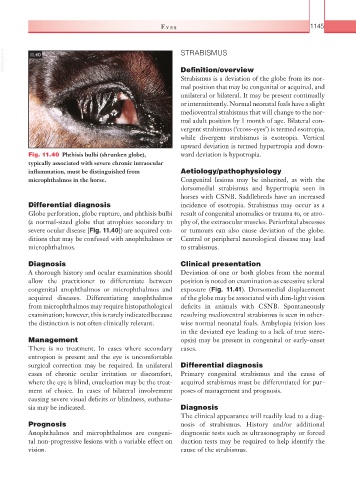Page 1170 - Equine Clinical Medicine, Surgery and Reproduction, 2nd Edition
P. 1170
Eyes 1145
VetBooks.ir 11.40 STRABISMUS
Definition/overview
Strabismus is a deviation of the globe from its nor-
mal position that may be congenital or acquired, and
unilateral or bilateral. It may be present continually
or intermittently. Normal neonatal foals have a slight
medioventral strabismus that will change to the nor-
mal adult position by 1 month of age. Bilateral con-
vergent strabismus (‘cross-eyes’) is termed esotropia,
while divergent strabismus is exotropia. Vertical
upward deviation is termed hypertropia and down-
Fig. 11.40 Phthisis bulbi (shrunken globe), ward deviation is hypotropia.
typically associated with severe chronic intraocular
inflammation, must be distinguished from Aetiology/pathophysiology
microphthalmos in the horse. Congenital lesions may be inherited, as with the
dorsomedial strabismus and hypertropia seen in
horses with CSNB. Saddlebreds have an increased
Differential diagnosis incidence of esotropia. Strabismus may occur as a
Globe perforation, globe rupture, and phthisis bulbi result of congenital anomalies or trauma to, or atro-
(a normal-sized globe that atrophies secondary to phy of, the extraocular muscles. Periorbital abscesses
severe ocular disease [Fig. 11.40]) are acquired con- or tumours can also cause deviation of the globe.
ditions that may be confused with anophthalmos or Central or peripheral neurological disease may lead
microphthalmos. to strabismus.
Diagnosis Clinical presentation
A thorough history and ocular examination should Deviation of one or both globes from the normal
allow the practitioner to differentiate between position is noted on examination as excessive scleral
congenital anophthalmos or microphthalmos and exposure (Fig. 11.41). Dorsomedial displacement
acquired diseases. Differentiating anophthalmos of the globe may be associated with dim-light vision
from microphthalmos may require histopathological deficits in animals with CSNB. Spontaneously
examination; however, this is rarely indicated because resolving medioventral strabismus is seen in other-
the distinction is not often clinically relevant. wise normal neonatal foals. Ambylopia (vision loss
in the deviated eye leading to a lack of true stere-
Management opsis) may be present in congenital or early-onset
There is no treatment. In cases where secondary cases.
entropion is present and the eye is uncomfortable
surgical correction may be required. In unilateral Differential diagnosis
cases of chronic ocular irritation or discomfort, Primary congenital strabismus and the cause of
where the eye is blind, enucleation may be the treat- acquired strabismus must be differentiated for pur-
ment of choice. In cases of bilateral involvement poses of management and prognosis.
causing severe visual deficits or blindness, euthana-
sia may be indicated. Diagnosis
The clinical appearance will readily lead to a diag-
Prognosis nosis of strabismus. History and/or additional
Anophthalmos and microphthalmos are congeni- diagnostic tests such as ultrasonography or forced
tal non-progressive lesions with a variable effect on duction tests may be required to help identify the
vision. cause of the strabismus.

